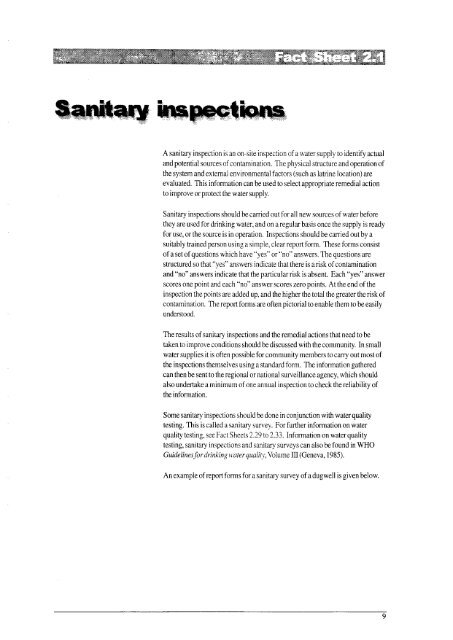A sanitary inspection is an on-site inspection of a water supply to ...
A sanitary inspection is an on-site inspection of a water supply to ...
A sanitary inspection is an on-site inspection of a water supply to ...
Create successful ePaper yourself
Turn your PDF publications into a flip-book with our unique Google optimized e-Paper software.
Fact Sheet 2.33Turbidity measurementThe import<str<strong>on</strong>g>an</str<strong>on</strong>g>ce <strong>of</strong> measuring turbidityTurbidity <str<strong>on</strong>g>is</str<strong>on</strong>g> the amount <strong>of</strong> cloudiness in the <strong>water</strong>. Th<str<strong>on</strong>g>is</str<strong>on</strong>g> c<str<strong>on</strong>g>an</str<strong>on</strong>g> vary from a river full<strong>of</strong> mud <str<strong>on</strong>g>an</str<strong>on</strong>g>d silt where it would be impossible <strong>to</strong> see through the <strong>water</strong> (highturbidity), <strong>to</strong> a spring <strong>water</strong> which appears <strong>to</strong> be completely clear (low turbidity).Turbidityc<str<strong>on</strong>g>an</str<strong>on</strong>g> be caused by :• silt, s<str<strong>on</strong>g>an</str<strong>on</strong>g>d <str<strong>on</strong>g>an</str<strong>on</strong>g>d mud ;• bacteria <str<strong>on</strong>g>an</str<strong>on</strong>g>d other germs ;• chemical precipitates.It <str<strong>on</strong>g>is</str<strong>on</strong>g> very import<str<strong>on</strong>g>an</str<strong>on</strong>g>t <strong>to</strong> measure the turbidity <strong>of</strong> domestic <strong>water</strong> supplies, as these supplies<strong>of</strong>ten undergo some type <strong>of</strong> <strong>water</strong> treatment which c<str<strong>on</strong>g>an</str<strong>on</strong>g> be affected by turbidity. Forexample, during the rainy seas<strong>on</strong> when mud <str<strong>on</strong>g>an</str<strong>on</strong>g>d silt are washed in<strong>to</strong> rivers <str<strong>on</strong>g>an</str<strong>on</strong>g>d streams,high turbidity c<str<strong>on</strong>g>an</str<strong>on</strong>g> quickly block filters <str<strong>on</strong>g>an</str<strong>on</strong>g>d s<strong>to</strong>p them from workingeffectively. Highturbidity will also fill t<str<strong>on</strong>g>an</str<strong>on</strong>g>ks <str<strong>on</strong>g>an</str<strong>on</strong>g>d pipes with mud <str<strong>on</strong>g>an</str<strong>on</strong>g>d silt, <str<strong>on</strong>g>an</str<strong>on</strong>g>d c<str<strong>on</strong>g>an</str<strong>on</strong>g> damage valves <str<strong>on</strong>g>an</str<strong>on</strong>g>d taps.Where chlorinati<strong>on</strong> <strong>of</strong> <strong>water</strong> <str<strong>on</strong>g>is</str<strong>on</strong>g> pract<str<strong>on</strong>g>is</str<strong>on</strong>g>ed, even quite low turbidity will prevent thechlorine killing the germs in the <strong>water</strong> efficiently.Some treatment systems, such as sedimen<strong>to</strong>rs, coagula<strong>to</strong>rs <str<strong>on</strong>g>an</str<strong>on</strong>g>d gravel prefilters aredesigned <strong>to</strong> remove turbidity. It <str<strong>on</strong>g>is</str<strong>on</strong>g> import<str<strong>on</strong>g>an</str<strong>on</strong>g>t for opera<strong>to</strong>rs <strong>of</strong> both large <str<strong>on</strong>g>an</str<strong>on</strong>g>d smalltreatment systems <strong>to</strong> know how well these systems are working. Measuring the turbidity<strong>of</strong> the <strong>water</strong> before <str<strong>on</strong>g>an</str<strong>on</strong>g>d after each part <strong>of</strong> the system c<str<strong>on</strong>g>an</str<strong>on</strong>g> tell the opera<strong>to</strong>r wheremainten<str<strong>on</strong>g>an</str<strong>on</strong>g>ce or cle<str<strong>on</strong>g>an</str<strong>on</strong>g>ing <str<strong>on</strong>g>is</str<strong>on</strong>g> needed.Measuring turbidityTurbidity c<str<strong>on</strong>g>an</str<strong>on</strong>g> be measured using either <str<strong>on</strong>g>an</str<strong>on</strong>g> electr<strong>on</strong>ic turbidity meter or a turbidity tube.Both methods have adv<str<strong>on</strong>g>an</str<strong>on</strong>g>tages <str<strong>on</strong>g>an</str<strong>on</strong>g>d d<str<strong>on</strong>g>is</str<strong>on</strong>g>adv<str<strong>on</strong>g>an</str<strong>on</strong>g>tages, as shown below. Turbidity <str<strong>on</strong>g>is</str<strong>on</strong>g> usuallymeasured in nephelometric turbidity units (NTU) or Jacks<strong>on</strong> turbidity units (JTLJ),depending <strong>on</strong> the method used for measurement. The two units are roughly equal.
Turbidity meterFact Sheet 2.33There are m<str<strong>on</strong>g>an</str<strong>on</strong>g>y different types <strong>of</strong> electr<strong>on</strong>ic turbidity meter available. Their adv<str<strong>on</strong>g>an</str<strong>on</strong>g>tages<str<strong>on</strong>g>an</str<strong>on</strong>g>d d<str<strong>on</strong>g>is</str<strong>on</strong>g>adv<str<strong>on</strong>g>an</str<strong>on</strong>g>tages are as follows :Adv<str<strong>on</strong>g>an</str<strong>on</strong>g>tages• very accurate, <str<strong>on</strong>g>an</str<strong>on</strong>g>d especially useful for measuring very low turbidities (less th<str<strong>on</strong>g>an</str<strong>on</strong>g> 5TU)D<str<strong>on</strong>g>is</str<strong>on</strong>g>adv<str<strong>on</strong>g>an</str<strong>on</strong>g>tages• high cost• need power <strong>supply</strong> (mains or battery)• easily damagedIt <str<strong>on</strong>g>is</str<strong>on</strong>g> impossible <strong>to</strong> give general guidelines <strong>on</strong> their use here.You should refer <strong>to</strong>m<str<strong>on</strong>g>an</str<strong>on</strong>g>ufacturers' instructi<strong>on</strong>s for use <str<strong>on</strong>g>an</str<strong>on</strong>g>d mainten<str<strong>on</strong>g>an</str<strong>on</strong>g>ce <strong>of</strong> these meters. Figure 1shows <str<strong>on</strong>g>an</str<strong>on</strong>g> example <strong>of</strong> <str<strong>on</strong>g>an</str<strong>on</strong>g> electr<strong>on</strong>ic turbidity meter.Figure 1. Turbidity meter
Fact Sheet 2.33Turbidity tubeThe adv<str<strong>on</strong>g>an</str<strong>on</strong>g>tages <str<strong>on</strong>g>an</str<strong>on</strong>g>d d<str<strong>on</strong>g>is</str<strong>on</strong>g>adv<str<strong>on</strong>g>an</str<strong>on</strong>g>tages <strong>of</strong> the turbidity tube are asfollows :Adv<str<strong>on</strong>g>an</str<strong>on</strong>g>tages• simple design• low cost• not easily damagedD<str<strong>on</strong>g>is</str<strong>on</strong>g>adv<str<strong>on</strong>g>an</str<strong>on</strong>g>tages• c<str<strong>on</strong>g>an</str<strong>on</strong>g>not measure very low turbidities (usual minimum <str<strong>on</strong>g>is</str<strong>on</strong>g> 5TU)• less prec<str<strong>on</strong>g>is</str<strong>on</strong>g>eSince the turbidity tube <str<strong>on</strong>g>is</str<strong>on</strong>g> simple <strong>to</strong> use, instructi<strong>on</strong>s are givenbelow. It <str<strong>on</strong>g>is</str<strong>on</strong>g>, however, recommended that you refer <strong>to</strong> theinstructi<strong>on</strong>s provided with the tube that you are using.A turbiditytube <str<strong>on</strong>g>is</str<strong>on</strong>g> shown in Figure 2.Figure 2. A turbidity tubeTo measure the turbidity <strong>of</strong> a <strong>water</strong> sample using a turbidity tube :• Where the tube <str<strong>on</strong>g>is</str<strong>on</strong>g> in two parts, push the two parts <strong>to</strong>gether; making sure that theyfit squarely.• Take a sample <strong>of</strong> <strong>water</strong> from the <strong>water</strong> source..• Hold the tube in <strong>on</strong>e h<str<strong>on</strong>g>an</str<strong>on</strong>g>d near the bot<strong>to</strong>m <str<strong>on</strong>g>an</str<strong>on</strong>g>d look in<strong>to</strong> the open end with yourhead about 10 <strong>to</strong> 20 centimetres above the tube, so that you c<str<strong>on</strong>g>an</str<strong>on</strong>g> clearly see theblack circle,
Fact Sheet 2.33• cross or other murk <strong>on</strong> the bot<strong>to</strong>m <strong>of</strong> the tube.• Slowly pour the <strong>water</strong> sample in<strong>to</strong> the tube, waiting for air bubbles <strong>to</strong> r<str<strong>on</strong>g>is</str<strong>on</strong>g>e ifnecessary, until the mark <strong>on</strong> the bot<strong>to</strong>m <strong>of</strong> the tube just d<str<strong>on</strong>g>is</str<strong>on</strong>g>appears.• S<strong>to</strong>p pouring the <strong>water</strong> sample in<strong>to</strong> the tube <str<strong>on</strong>g>an</str<strong>on</strong>g>d look at the level <strong>of</strong> <strong>water</strong> in thetube. For turbidity tubes which have a turbidity scale marked <strong>on</strong> the side, read thenumber <strong>on</strong> the nearest line <strong>to</strong> the <strong>water</strong> level. Th<str<strong>on</strong>g>is</str<strong>on</strong>g> <str<strong>on</strong>g>is</str<strong>on</strong>g> the turbidity o f the <strong>water</strong>. I fthe tube does not have a scale marked, measure the d<str<strong>on</strong>g>is</str<strong>on</strong>g>t<str<strong>on</strong>g>an</str<strong>on</strong>g>ce from the bott<strong>on</strong>z o fthe tube <strong>to</strong> the <strong>water</strong> level with a tape measure <str<strong>on</strong>g>an</str<strong>on</strong>g>d look up or calculate theturbidity o f the <strong>water</strong> sample using the instructi<strong>on</strong>s provided with the tube.• After use, wash the tube in cle<str<strong>on</strong>g>an</str<strong>on</strong>g> <strong>water</strong> <str<strong>on</strong>g>an</str<strong>on</strong>g>d s<strong>to</strong>re the two parts <strong>of</strong> the tube where they c<str<strong>on</strong>g>an</str<strong>on</strong>g>notbe damaged.Turbidity guidelines for drinking <strong>water</strong>For drinking <strong>water</strong> supplies, the following guidelines should be taken in<strong>to</strong> c<strong>on</strong>siderati<strong>on</strong> :• Drinking <strong>water</strong> should have a turbidity <strong>of</strong> 5 NTU/JTU or less. Turbidity <strong>of</strong> moreth<str<strong>on</strong>g>an</str<strong>on</strong>g> 5 NTU/JTU would be noticed by users <str<strong>on</strong>g>an</str<strong>on</strong>g>d may cause rejecti<strong>on</strong> <strong>of</strong> the <strong>supply</strong>.• Where <strong>water</strong> <str<strong>on</strong>g>is</str<strong>on</strong>g> chlorinated, turbidity should be less th<str<strong>on</strong>g>an</str<strong>on</strong>g> 5 NTU/JTU <str<strong>on</strong>g>an</str<strong>on</strong>g>dpreferably less th<str<strong>on</strong>g>an</str<strong>on</strong>g> 1 NTU/JTU for chlorinati<strong>on</strong> <strong>to</strong> be effective.

















